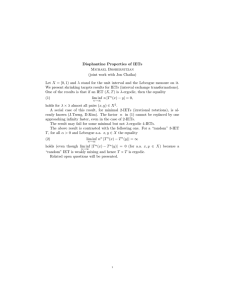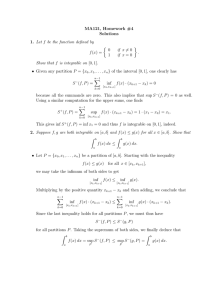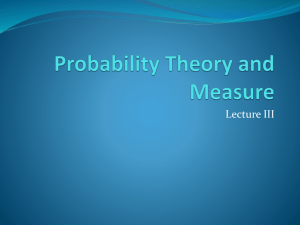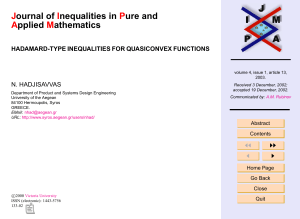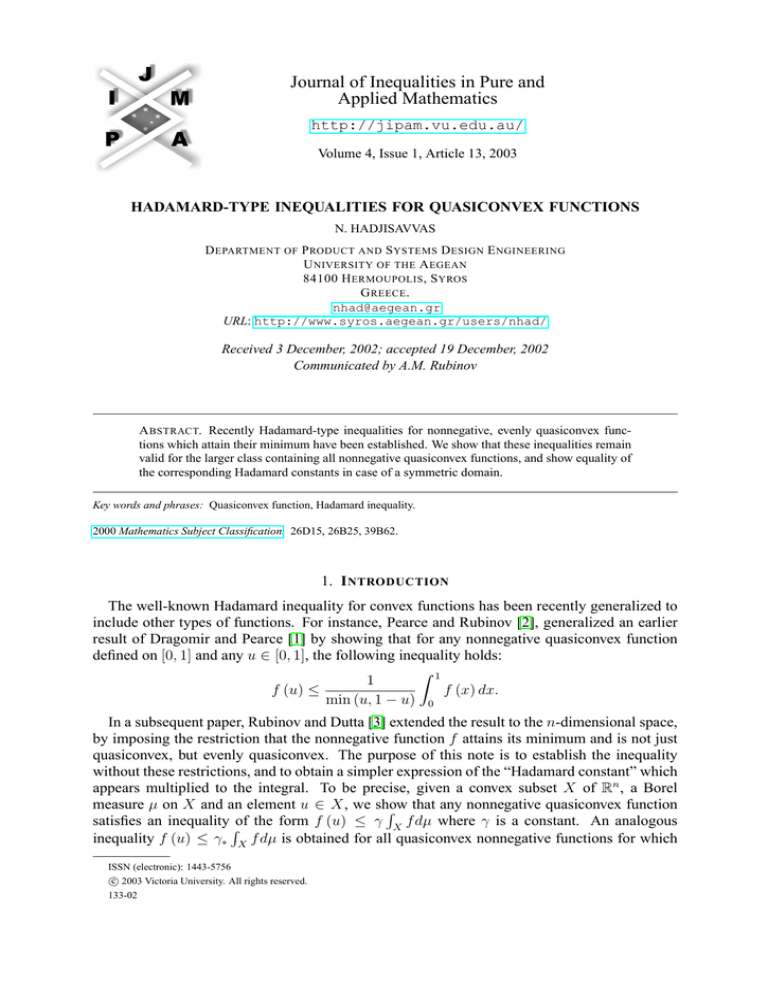
Journal of Inequalities in Pure and
Applied Mathematics
http://jipam.vu.edu.au/
Volume 4, Issue 1, Article 13, 2003
HADAMARD-TYPE INEQUALITIES FOR QUASICONVEX FUNCTIONS
N. HADJISAVVAS
D EPARTMENT OF P RODUCT AND S YSTEMS D ESIGN E NGINEERING
U NIVERSITY OF THE A EGEAN
84100 H ERMOUPOLIS , S YROS
G REECE .
nhad@aegean.gr
URL: http://www.syros.aegean.gr/users/nhad/
Received 3 December, 2002; accepted 19 December, 2002
Communicated by A.M. Rubinov
A BSTRACT. Recently Hadamard-type inequalities for nonnegative, evenly quasiconvex functions which attain their minimum have been established. We show that these inequalities remain
valid for the larger class containing all nonnegative quasiconvex functions, and show equality of
the corresponding Hadamard constants in case of a symmetric domain.
Key words and phrases: Quasiconvex function, Hadamard inequality.
2000 Mathematics Subject Classification. 26D15, 26B25, 39B62.
1. I NTRODUCTION
The well-known Hadamard inequality for convex functions has been recently generalized to
include other types of functions. For instance, Pearce and Rubinov [2], generalized an earlier
result of Dragomir and Pearce [1] by showing that for any nonnegative quasiconvex function
defined on [0, 1] and any u ∈ [0, 1], the following inequality holds:
Z 1
1
f (u) ≤
f (x) dx.
min (u, 1 − u) 0
In a subsequent paper, Rubinov and Dutta [3] extended the result to the n-dimensional space,
by imposing the restriction that the nonnegative function f attains its minimum and is not just
quasiconvex, but evenly quasiconvex. The purpose of this note is to establish the inequality
without these restrictions, and to obtain a simpler expression of the “Hadamard constant” which
appears multiplied to the integral. To be precise, given a convex subset X of Rn , a Borel
measure µ on X and an element u ∈ X, we show
R that any nonnegative quasiconvex function
satisfies an inequality Rof the form f (u) ≤ γ X f dµ where γ is a constant. An analogous
inequality f (u) ≤ γ∗ X f dµ is obtained for all quasiconvex nonnegative functions for which
ISSN (electronic): 1443-5756
c 2003 Victoria University. All rights reserved.
133-02
2
N. H ADJISAVVAS
f (0) = 0 (under the assumption that 0 ∈ X). We obtain simple expressions for the constants γ
and γ∗ and show that they are equal, under a symmetry assumption.
In what follows, X is a convex, Borel subset of Rn , µ is a finite Borel measure on X, and λ
is the Lebesgue measure. As usual, µ λ means that µ is absolutely continuous with respect
to λ. The open (closed) ball with center u and radius r will be denoted by B (u, r) (B (u, r)).
We denote by S the sphere {x ∈ Rn : kxk = 1} and set, for each v ∈ S, u ∈ R,
Xv,u = {x ∈ X : hv, x − ui > 0} .
(1.1)
2. I NEQUALITY FOR Q UASICONVEX F UNCTIONS
The following proposition shows that the Hadamard-type inequality for nonnegative evenly
quasiconvex functions that attain their minimum, established in [3], is true for all nonnegative
quasiconvex, Borel measurable functions.
Proposition 2.1. Let f : X → R∪ {+∞} be a Borel measurable, nonnegative quasiconvex
function. Then for every u ∈ X, the following inequality holds:
Z
(2.1)
inf µ (Xv,u ) f (u) ≤
f dµ.
v∈S
X
Proof. Let L = {x ∈ X : f (x) < f (u)}. Then L is convex and u does not belong to the
relative interior of L. We can thus separate u and L by a hyperplane, i.e., there exists v ∈ S
such that ∀x ∈ L, hx, vi ≤ hu, vi. Hence, for every x ∈ Xv,u , f (x) ≥ f (u). Consequently,
Z
Z
µ (Xv,u ) f (u) ≤
f dµ ≤
f dµ
Xv,u
X
from which follows relation (2.1).
Note that if µ = λ, then we do not have to assume f to be Borel measurable. Indeed, any
convex subset of Rn is Lebesgue measurable since it can be written as the union of its interior
and a subset of its boundary; the latter is a Lebesgue null set, thus is Lebesgue measurable.
Consequently, every quasiconvex function is Lebesgue measurable since by definition its level
sets are convex.
It is possible that inf v∈S µ (Xv,u ) = 0. In this case relation (2.1) does not say much. We can
avoid this if u ∈ int X and µ does not vanish on sets of nonzero Lebesgue measure:
Proposition 2.2. Assumptions as in Proposition 2.1.
(i) If u ∈ int X and λ µ, then inf v∈S µ (Xv,u ) > 0.
(ii) If u ∈
/ int X and µ λ, then inf v∈S µ (Xv,u ) = 0.
Proof.
(i) Let ε > 0 be such that B (u, ε) ⊆ X. For each v ∈ S and x ∈ B u + 2ε v, 2ε ,
the triangle inequality yields
kx − uk ≤ x − u + 2ε v + 2ε v < ε
hence x ∈ X. Also,
hv, x − ui = v, x − u + 2ε v + v, 2ε v ≥ − kvk x − u + 2ε v +
Consequently, x ∈ Xv,u , i.e., B u + 2ε v, 2ε ⊆ Xv,u . Hence,
inf λ (Xv,u ) ≥ λ B u + 2ε v, 2ε = λ B 0, 2ε > 0.
ε
2
> 0.
v∈S
By absolute continuity, inf v∈S µ (Xv,u ) > 0.
J. Inequal. Pure and Appl. Math., 4(1) Art. 13, 2003
http://jipam.vu.edu.au/
H ADAMARD I NEQUALITY
3
(ii) Since u ∈
/ int X, we can separate u and X by a hyperplane. It follows that for some
v ∈ S, the set Xv,u is a subset of this hyperplane, hence λ (Xv,u ) = 0 which entails that
µ (Xv,u ) = 0.
Let us set
γ=
(2.2)
where we make the convention
(2.3)
1
0
1
,
inf v∈S µ (Xv,u )
= +∞. Then we can write (2.1) in the form
Z
f (u) ≤ γ
f dµ.
X
The following Lemma will be useful for obtaining alternative expressions of “Hadamard
constants” such as γ and showing their sharpness. In particular, it shows that Xv,u could have
been defined (see relation (1.1)) by using ≥ instead of >. Let
X v,u = {x ∈ X : hv, x − ui ≥ 0}
(2.4)
be the closure of Xv,u in X.
Lemma 2.3. If µ λ, then
(i) µ (Xv,u ) = µ X v,u ;
(ii) The function v → µ (Xv,u ) is continuous on S.
(i) We know that λ ({x ∈ Rn : hv, x − ui = 0}) = 0; consequently, λ X v,u \Xv,u =
0 and this entails that µ X v,u \Xv,u = 0.
(ii) Suppose that (vn ) is a sequence in S, converging
to v. Let ε > 0 be given. Choose
r > 0 large enough so that µ X\B (u, r) < ε/2. Let us show that
lim λ Xvn ,u ∩ B (u, r) = λ Xv,u ∩ B (u, r) .
Proof.
n→∞
For this it is sufficient to show that limn→∞ λ (Xn ) = 0 where Xn is the symmetric
difference ((Xv,u \Xvn ,u ) ∪ (Xvn ,u \Xv,u )) ∩ B (u, r). If x ∈ Xn then kx − uk ≤ r and
hv, x − ui > 0 ≥ hvn , x − ui
(2.5)
or
(2.6)
hvn , x − ui > 0 ≥ hv, x − ui .
If, say, (2.6) is true, then hv, x − ui ≤ 0 < hvn − v, x − ui+hv, x − ui ≤ kvn − vk r+
hv, x − ui thus |hv, x − ui| ≤ kvn − vk r. The same can be deduced if (2.5) is true.
Thus the projection of Xn on v can be arbitrarily small; since Xn is contained in B (u, r)
this means that limn→∞ λ (Xn ) = 0 as claimed.
By absolute continuity, limn→∞ µ Xvn ,u ∩ B (u, r) = µ Xv,u ∩ B (u, r) . Since
|µ (Xvn ,u ) − µ (Xv,u )| ≤ µ Xvn ,u ∩ B (u, r) − µ Xv,u ∩ B (u, r) + µ Xvn ,u \B (u, r) + µ Xv,u \B (u, r) ≤ µ Xvn ,u ∩ B (u, r) − µ Xv,u ∩ B (u, r) + ε,
it follows that limn→∞ |µ (Xvn ,u ) − µ (Xv,u )| ≤ ε. This is true for all ε > 0, hence
limn→∞ µ (Xvn ,u ) = µ (Xv,u ).
J. Inequal. Pure and Appl. Math., 4(1) Art. 13, 2003
http://jipam.vu.edu.au/
4
N. H ADJISAVVAS
We now obtain an alternative expression for the “Hadamard constant” γ, analogous to the
one in [3]. For u ∈ X define
n
A+
u = {(v, x0 ) ∈ R × X : hv, u − x0 i ≥ 1} .
Further, given v ∈ Rn and x0 ∈ X set1
+
Xv,x
= {x ∈ X : hv, x − x0 i > 1} .
0
Proposition 2.4. The following equality holds for every u ∈ int X:
γ=
1
+
inf (v,x0 )∈A+u µ Xv,x
0
.
0
Proof. For every (v, x0 ) ∈ A+
u , we set v = v/ kvk. For each x ∈ Xv 0 ,u , hv, x − ui > 0
+
holds. Besides, (v, x0 ) ∈ Au implies that hv, u − x0 i ≥ 1. Hence, hv, x − x0 i = hv, x − ui +
+
+
hv, u − x0 i > 1 thus x ∈ Xv,x
. It follows that Xv0 ,u ⊆ Xv,x
; consequently,
0
0
+
(2.7)
inf + µ Xv,x
≥ inf µ (Xv,u ) .
0
v∈S
(v,x0 )∈Au
To show the reverse inequality, let v ∈ S be given. Since u ∈ int X, we may find x0 ∈ X such
that hv, u − x0 i > 0. Choose t > 0 so that for v 0 = tv one has hv 0 , u − x0 i = 1. The following
equivalences hold:
x ∈ Xv+0 ,x0 ⇔ hv 0 , x − x0 i > 1
⇔ hv 0 , x − ui + hv 0 , u − x0 i > 1
⇔ hv 0 , x − ui > 0
⇔ hv, x − ui > 0
⇔ x ∈ Xv,u .
+
Thus, for every v ∈ S there exists (v 0 , x0 ) ∈ A+
u such that Xv,u = Xv 0 ,x0 . Hence equality holds
in (2.7).
3. I NEQUALITY FOR Q UASICONVEX F UNCTIONS SUCH
THAT
f (0) = 0.
Whenever 0 ∈ X and f (0) = 0, another Hadamard-type inequality has being obtained in [3],
assuming that f is nonnegative and evenly quasiconvex. We generalize this result to nonnegative
quasiconvex functions and compare with the previous findings. Let h : R+ → R+ be increasing
c
with h (c) > 0 for all c > 0 and λh := supc>0 h(c)
< +∞ (we follow the notation of [3]).
Proposition 3.1. Let f : X → R ∪ {+∞} be Borel measurable, nonnegative and quasiconvex.
If 0 ∈ X and f (0) = 0, then for every u ∈ X,
Z
(3.1)
inf
µ (Xv,u ) f (u) ≤ λh
h (f (x)) dµ.
v∈S,hv,ui≥0
X
Proof. If f (u) = 0 we have nothing to prove. Suppose that f (u) > 0. Coming back to the
proof of Proposition 2.1, we know that there exists v ∈ S such that ∀x ∈ Xv,u , f (x) ≥ f (u);
hence h (f (x)) ≥ h (f (u)), from which it follows that
Z
Z
µ (Xv,u ) h (f (u)) ≤
h (f (x)) dµ ≤
h (f (x)) dµ.
Xv,u
1
X
There is sometimes a change in notation with respect to [3].
J. Inequal. Pure and Appl. Math., 4(1) Art. 13, 2003
http://jipam.vu.edu.au/
H ADAMARD I NEQUALITY
5
Note that 0 ∈
/ Xv,u because f (0) < f (u); thus, hv, ui ≥ 0. Consequently,
Z
h (f (x)) dµ.
inf
µ (Xv,u ) h (f (u)) ≤
v∈S,hv,ui≥0
X
Finally, note that by definition of λh , f (u) ≤ λh h (f (u)) from which follows (3.1).
Note that relation (3.1) is only interesting if u 6= 0 since otherwise it is trivially true. Let us
define γ∗ by
1
if u 6= 0
(3.2)
γ∗ =
inf
µ (Xv,u )
0 v∈S,hv,ui≥0
if u = 0.
We obtain an alternative expression for γ∗ , similar to that in [3]. Given u ∈ X\ {0}, set
Bu = {v ∈ Rn : hv, ui ≥ 1}, and for any v ∈ Rn , set Xv+ = {x ∈ X : hv, xi > 1}.
Proposition 3.2. The following equality holds for every u ∈ X\ {0}:
inf µ Xv+ =
inf
µ (Xv,u ) .
v∈Bu
v∈S,hv,ui>0
Proof. For every v ∈ Bu we set v 0 = v/ kvk and show that Xv0 ,u ⊆ Xv+ . Indeed, if x ∈ Xv0 ,u ,
then we have hv, x − ui > 0 hence hv, xi = hv, ui + hv, x − ui > 1, i.e., x ∈ Xv+ . Since
hv 0 , ui > 0, it follows that
(3.3)
inf µ Xv+ ≥
inf
µ (Xv,u ) .
v∈Bu
v∈S,hv,ui>0
To show equality, let v ∈ S be such that hv, ui > 0. Choose t > 0 such that t hv, ui = 1 and
set v 0 = tv. For every x ∈ Xv+0 one has hv 0 , xi > 1, hence,
hv 0 , x − ui = hv 0 , xi − hv 0 , ui > 0.
It follows that hv, x − ui > 0, i.e., x ∈ Xv,u . Thus, Xv+0 ⊆ Xv,u and v 0 ∈ Bu . This shows
that in (3.3) equality holds.
Proposition 3.3. If µ λ then we also have the equalities
1
1
(if u 6= 0)
γ∗ =
=
inf v∈S,hv,ui>0 µ (Xv,u )
minv∈S,hv,ui≥0 µ X v,u
1
.
(3.4)
γ=
minv∈S µ X v,u
Proof. We first observe that, according to Lemma 2.3, µ X v,u = µ (Xv,u ). The same lemma
entails that inf v∈S,hv,ui>0 µ (Xv,u ) = inf v∈S,hv,ui≥0 µ (Xv,u ) and that this infimum is attained,
since the set {v ∈ S : hv, ui ≥ 0} is compact. In the same way, the infimum in (2.2) is attained.
Whenever µ λ, the constant γ is sharp, in the sense
R that given u ∈ X, there exists a
nonnegative quasiconvex function f such that f (u) = γ X f dµ. Indeed, since the minimum
in (3.4) is attained for some v0 ∈ S, it is sufficient to take f to be the characteristic function of
X v0 ,u (see Corollary 2 of [3]). Analogous considerations can be made for γ∗ (see Corollary 4
of [3]).
We now show the equality of γ and γ∗ under a symmetry assumption:
Corollary 3.4. Suppose that X has 0 as center of symmetry, u ∈ int X\ {0} and µ λ. If
µ (A) = µ (−A) for every Borel A ⊆ X, then γ = γ∗ .
J. Inequal. Pure and Appl. Math., 4(1) Art. 13, 2003
http://jipam.vu.edu.au/
6
N. H ADJISAVVAS
Proof. For every v ∈ S such that hv, ui < 0, set v 0 = −v and Y = {x ∈ X : hv, x + ui > 0}.
Since 0 is a center of symmetry, one can check that Y = −Xv0 ,u .
If x ∈ Y then hv, x − ui = hv, x + ui − 2 hv, ui > 0. Thus, Y ⊆ Xv,u and µ (Xv,u ) ≥
µ (Y ) = µ (Xv0 ,u ). It follows that the minimum in (3.4) can be restricted to v ∈ S such that
hv, ui ≥ 0. Thus, γ = γ∗ .
R EFERENCES
[1] S.S. DRAGOMIR AND C.E.M. PEARCE, Quasi-convex functions and Hadamard’s inequality, Bull.
Austral. Math. Soc., 57 (1998), 377–385.
[2] C.E.M. PEARCE AND A.M. RUBINOV, P –functions, quasiconvex functions and Hadamard-type
inequalities, J. Math. Anal. Appl., 240 (1999), 92–104.
[3] A.M. RUBINOV AND J. DUTTA, Hadamard type inequalities for quasiconvex functions in higher
dimensions, J. Math. Anal. Appl., 270 (2002), 80–91.
J. Inequal. Pure and Appl. Math., 4(1) Art. 13, 2003
http://jipam.vu.edu.au/



